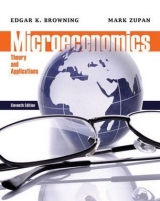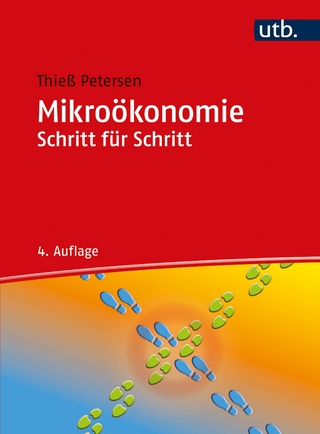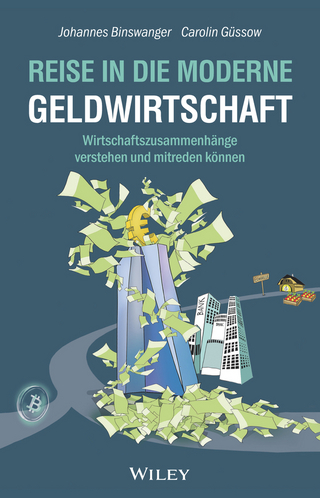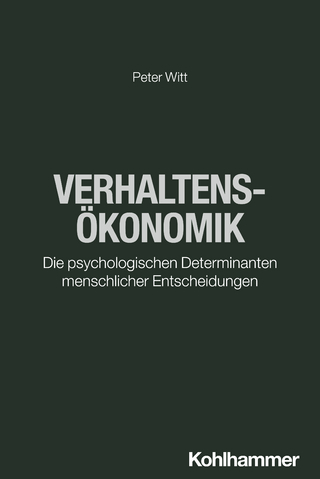
Microeconomics
John Wiley & Sons Inc (Verlag)
978-0-470-12891-6 (ISBN)
- Titel erscheint in neuer Auflage
- Artikel merken
The 10th edition of Browning and Zupan's Microeconomics: Theory and Applications continues to motivate students and introduce them to current thinking in the field. This book appeals to students and instructors alike because of its accessibility, large number of applications, and the clear step-by-step manner in which graphs are introduced. In this new edition, the authors have included more applications and more mathematical material to reinforce students’ understanding of basic microeconomic principles. This knowledge of microeconomic theory will serve as an essential foundation for any business major or for those preparing for a future career as a business professional.
Edgar K. Browning is the Alfred F. Chalk Professor of Economics at Texas A&M University; his specialty is Public Economics. He earned a B.A. in Economics from the University of Virginia and a Ph.D. in Economics from Princeton University in 1971. A selected list of his publications include “ A Neglected Welfare Cost of Monopoly- and Most other Product Market Distortions,” Journal of Public Economics, 1997; The Non-Tax Wedge,” Journal of Public Economics, 1994; “The Marginal Cost of Redistribution,” Public Finance Quarterly, 1993; “On the Marginal Welfare Cost of Taxation,” American Economic Review, 1987; “The Trade-Off Between Equality and Efficiency,” Journal of Political Economy, 1984.
Preface v
Acknowledgments x
Chapter 1: An Introduction to Microeconomics 1
1.1 The Scope of Microeconomic Theory 2
1.2 The Nature and Role of Theory 2
1.3 Positive Versus Normative Analysis 4
1.4 Market Analysis and Real Versus Nominal Prices 5
1.5 Basic Assumptions about Market Participants 6
1.6 Opportunity Cost 7
1.7 Production Possibility Frontier 10
Chapter 2: Supply and Demand 15
2.1 Demand and Supply Curves 16
2.2 Determination of Equilibrium Price and Quantity 23
2.3 Adjustment to Changes in Demand or Supply 25
2.4 Government Intervention in Markets: Price Controls 29
2.5 Elasticities 34
2.6 The Mathematics Associated with Elasticities 43
Chapter 3: The Theory of Consumer Choice 48
3.1 Consumer Preferences 50
3.2 The Budget Constraint 58
3.3 The Consumer’s Choice 63
3.4 Changes in Income and Consumption Choices 67
3.5 Are People Selfish? 74
3.6 The Utility Approach to Consumer Choice 77
3.7 The Mathematics Behind Consumer Choice 80
Chapter 4: Individual and Market Demand 85
4.1 Price Changes and Consumption Choices 86
4.2 Income and Substitution Effects of a Price Change 90
4.3 Income and Substitution Effects: Inferior Goods 96
4.4 From Individual to Market Demand 99
4.5 Consumer Surplus 101
4.6 Price Elasticity and the Price-Consumption Curve 107
4.7 Network Effects 109
4.8 The Basics of Demand Estimation 113
4.9 Deriving the Consumer’s Demand Curve Mathematically 117
Chapter 5: Using Consumer Choice Theory 122
5.1 Excise Subsidies, Health Care, and Consumer Welfare 123
5.2 Public Schools and the Voucher Proposal 128
5.3 Paying for Garbage 132
5.4 The Consumer’s Choice to Save or Borrow 135
5.5 Investor Choice 142
Chapter 6: Exchange, Efficiency, and Prices 152
6.1 Two-Person Exchange 153
6.2 Efficiency in the Distribution of Goods 159
6.3 Competitive Equilibrium and Efficient Distribution 163
6.4 Price and Nonprice Rationing and Efficiency 167
6.5 Some of the Mathematics Behind Efficiency in Exchange 170
Chapter 7: Production 174
7.1 Relating Output to Inputs 175
7.2 Production When Only One Input Is Variable: The Short Run 176
7.3 Production When All Inputs Are Variable: The Long Run 183
7.4 Returns to Scale 188
7.5 Functional Forms and Empirical Estimation of Production Functions 191
7.6 The Mathematics behind Production Theory 195
Chapter 8: The Cost of Production 201
8.1 The Nature of Cost 202
8.2 Short-Run Cost of Production 203
8.3 Short-Run Cost Curves 206
8.4 Long-Run Cost of Production 212
8.5 Input Price Changes and Cost Curves 218
8.6 Long-Run Cost Curves 221
8.7 Learning by Doing 224
8.8 Importance of Cost Curves to Market Structure 226
8.9 Using Cost Curves: Controlling Pollution 229
8.10 Economies of Scope 232
8.11 Estimating Cost Functions 233
8.12 The Mathematics Behind Production Cost 234
Chapter 9: Profit Maximization in Perfectly Competitive Markets 240
9.1 The Assumptions of Perfect Competition 241
9.2 Profit Maximization 243
9.3 The Demand Curve Facing the Competitive Firm 244
9.4 Short-Run Profit Maximization 246
9.5 The Perfectly Competitive Firm’s Short-Run Supply Curve 251
9.6 The Short-Run Industry Supply Curve 255
9.7 Long-Run Competitive Equilibrium 257
9.8 The Long-Run Industry Supply Curve 261
9.9 When Does the Competitive Model Apply? 269
9.10 The Mathematics Behind Perfect Competition 270
Chapter 10: Using the Competitive Model 275
10.1 The Evaluation of Gains and Losses 276
10.2 Excise Taxation 282
10.3 Airline Regulation and Deregulation 291
10.4 City Taxicab Markets 297
10.5 Consumer and Producer Surplus, and the Net Gains from Trade 300
10.6 Government Intervention in Markets: Quantity Controls 306
Chapter 11: Monopoly 312
11.1 The Monopolist’s Demand and Marginal Revenue Curves 313
11.2 Profit-Maximizing Output of a Monopoly 315
11.3 Further Implications of Monopoly Analysis. 321
11.4 The Measurement and Sources of Monopoly Power 325
11.5 The Efficiency Effects of Monopoly 331
11.6 Public Policy Toward Monopoly 335
11.7 The Mathematics Behind Monopoly 339
Chapter 12: Product Pricing with Monopoly Power 344
12.1 Price Discrimination 346
12.2 Three Necessary Conditions for Price Discrimination 350
12.3 Price and Output Determination with Price Discrimination 352
12.4 Intertemporal Price Discrimination and Peak-Load Pricing 356
12.5 Two-Part Tariffs 362
12.6 The Mathematics Behind Price Discrimination 367
Chapter 13: Monopolistic Competition and Oligopoly 371
13.1 Price and Output under Monopolistic Competition 372
13.2 Oligopoly and the Cournot Model 378
13.3 Other Oligopoly Models 384
13.4 Cartels and Collusion 390
Chapter 14: Game Theory and the Economics of Information 403
14.1 Game Theory 405
14.2 The Prisoner’s Dilemma Game 409
14.3 Repeated Games 414
14.4 Asymmetric Information 419
14.5 Adverse Selection and Moral Hazard 423
14.6 Limited Price Information 428
14.7 Advertising 430
Chapter 15: Using Noncompetitive Market Models 435
15.1 The Size of the Deadweight Loss of Monopoly 436
15.2 Do Monopolies Suppress Inventions? 440
15.3 Natural Monopoly 443
15.4 More on Game Theory: Iterated Dominance and Commitment 447
Chapter 16: Employment and Pricing of Inputs 456
16.1 The Input Demand Curve of a Competitive Firm 457
16.2 Industry and Market Demand Curves for an Input 463
16.3 The Supply of Inputs 466
16.4 Industry Determination of Price and Employment of Inputs 468
16.5 Input Price Determination in a Multi-Industry Market 471
16.6 Input Demand and Employment by an Output Market Monopoly 474
16.7 Monopsony in Input Markets 476
16.8 The Calculus Behind Input Demand by Competitive and Monopoly Firms 478
Chapter 17: Wages, Rent, Interest, and Profit 482
17.1 The Income-Leisure Choice of the Worker 483
17.2 The Supply of Hours of Work 486
17.3 The General Level of Wage Rates 491
17.4 Why Wages Differ 495
17.5 Economic Rent 498
17.6 Monopoly Power in Input Markets: The Case of Unions 500
17.7 Borrowing, Lending, and the Interest Rate 504
17.8 Investment and the Marginal Productivity of Capital 505
17.9 Saving, Investment, and the Interest Rate 508
17.10 Why Interest Rates Differ 510
Chapter 18: Using Input Market Analysis 513
18.1 The Minimum Wage 514
18.2 Who Really Pays for Social Security? 521
18.3 The Hidden Cost of Social Security 524
18.4 The NCAA Cartel 528
18.5 Discrimination in Employment 534
18.6 The Benefits and Costs of Immigration 538
Chapter 19: General Equilibrium Analysis and Economic Efficiency 545
19.1 Partial and General Equilibrium Analysis Compared 547
19.2 Economic Efficiency 550
19.3 Conditions for Economic Efficiency 553
19.4 Efficiency in Production 553
19.5 The Production Possibility Frontier and Efficiency in Output 557
19.6 Competitive Markets and Economic Efficiency 563
19.7 The Causes of Economic Inefficiency 566
Chapter 20: Public Goods and Externalities 571
20.1 What Are Public Goods? 573
20.2 Efficiency in the Provision of a Public Good 575
20.3 Externalities 579
20.4 Externalities and Property Rights 585
20.5 Controlling Pollution, Revisited 590
Glossary 605
Index 612
| Erscheint lt. Verlag | 22.9.2009 |
|---|---|
| Zusatzinfo | Drawings: 0 B&W, 0 Color |
| Verlagsort | New York |
| Sprache | englisch |
| Maße | 211 x 259 mm |
| Gewicht | 1196 g |
| Themenwelt | Wirtschaft ► Allgemeines / Lexika |
| Wirtschaft ► Volkswirtschaftslehre ► Mikroökonomie | |
| ISBN-10 | 0-470-12891-7 / 0470128917 |
| ISBN-13 | 978-0-470-12891-6 / 9780470128916 |
| Zustand | Neuware |
| Haben Sie eine Frage zum Produkt? |
aus dem Bereich



